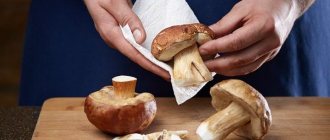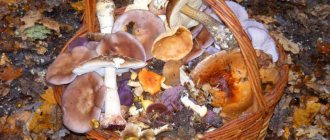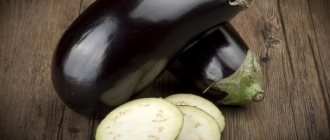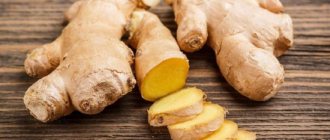Summer has not yet arrived, but mushroom pickers are already preparing baskets. And it’s not surprising, because quiet hunting can be done from May until late autumn. And if picking mushrooms at the beginning of May is for experts, then by the middle of the month you can find the well-known and beloved boletus mushrooms, and then, lo and behold, the boletus boletuses have ripened. These sponge mushrooms, along with porcini mushrooms, are considered elite. They are fried, made into soup, sauces are prepared, stewed, dried, pickled - mushrooms are suitable for any method of cooking. But before that, the mushrooms need to be cleaned.
Birch trophy
Boletus mushrooms
Silent hunting is called this for a reason: in order for the collector’s baskets to be filled with a fresh mushroom harvest, he needs to be as attentive and collected as possible. The first wave of gathering activity occurs in the middle - end of spring, when the forest glades, again covered with greenery, are filled with the first boletuses, which become more and more numerous with each new spring rain. In order to quickly and successfully find and identify boletus mushrooms, any collector needs to know exactly what this mushroom looks like and in what places it lives. Despite the name, boletus mushrooms are friends not only with birch, but also with other deciduous trees.
Pre-cleaning of mushrooms in the forest
The first stage of cleaning takes place in the forest. From each mushroom found, we remove the main debris: twigs, leaves, pine needles, moss. We clean the rhizome with a knife from soil and sand or simply cut it off to check for the presence of worms. Take with you on a “quiet hunt” a brush that can be used to clean the mushroom from sand and soil. We don’t accept “strangers.” It's like a drop of ointment in a barrel of ointment - one inedible mushroom in a basket can lead to poisoning. Let’s not be lazy: it’s better to immediately process each cut mushroom than to pore over a whole bunch later. This way you will save time and bring less garbage home.
We are not greedy: we leave wormy, “ancient” and moldy specimens to live out their lives in the forest.
Boletus mushrooms
The best mushrooms are boletus mushrooms.
These mushrooms grow abundantly in deciduous forests, often in the company of birch, but not necessarily next to it, in young plantings on the outskirts of forests, in forest clearings - wherever there is a lot of light and moisture. The peak growth of these mushrooms occurs in early to mid-summer, and boletus mushrooms usually bear fruit in three waves:
- The end of May - the beginning of June - approximately coinciding with the flowering period of mountain ash.
- Mid-June – end of July, during the linden flowering period.
- Mid-August – end of autumn.
Among the many species of boletus, there are several of the most famous and popular:
Common boletus is the most famous and widespread species. The cap of this mushroom has a light or dark brown color, and its diameter can reach 15 cm. The pulp of this species has a pleasant mushroom aroma, wonderful taste, dense consistency and the fact that it does not change color when cut.
Black boletus - likes to grow in wetter soil, in pine forests and along the edges of swamps. Fruits from July until the very end of summer. Its cap reaches a diameter of up to 8 cm and is painted black or dark brown, and characteristic dark scales are noticeable on the leg. The pulp of this species is looser, therefore, in culinary terms, it is less valued.
Boletus Marsh or White - this species especially loves dampness and grows along the edges of swamps and lakes, wherever there is a lot of moisture. Its cap is pale brown in color and can reach a diameter of up to 15 cm, and the leg is thinner and longer than that of other boletus mushrooms. The pulp does not change color when cut and has a weak mushroom taste and smell.
Boletus pinkish - grows in forests with well-moistened soil, has a cap with a diameter of up to 15 cm, cushion-shaped, colored brown or dark brown, and a not very thick stem. The dense and white flesh of this species turns pink when cut, which is where its name comes from.
How to clean, wash and soak boletuses after harvesting, processing for cooking, video
Boletuses and boletuses: how to peel, wash and soak
Mushrooms spoil too quickly, so you need to clean boletus and boletus mushrooms as soon as possible. To make the desired dish tasty, you need to properly prepare forest fruits.
How to wash boletus mushrooms
It is not recommended to wash the collected mushrooms immediately, as this will complicate the subsequent cleansing process. First of all, the redheads are properly cleaned, removing all dirt and cutting out areas that have been worn down by worms. Afterwards, the fruits are cut into pieces and immersed in cold water for 30 minutes to protect them from darkening. For every liter of water add 20 g of salt. After which they wash the crop under tap water. If whole mushrooms are used for subsequent preparation, then it is best to pick up each specimen and wash it separately. This way the cleaning will be more effective, and the pulp will not have time to absorb additional moisture.
If you need to preserve the neat appearance of the boletus or there is a possibility that the water jet will damage the mushroom pulp, then a more gentle method is used. To do this, fill a wide and, preferably, large basin with a lot more water. Add the prepared mushrooms and mix them carefully with your hand. Afterwards, the liquid is drained, new water is collected and the cleaning process is repeated 2 more times.
You can also place the sorted and peeled boletuses in a colander and completely load them into a bowl of water a couple of times. Drain the liquid and, filling it again, wash it in the same way.
You need to wash forest fruits quickly so that the caps do not absorb unused moisture, which will damage the taste of the boletus.
Is it necessary to clean boletus mushrooms?
Boletuses and boletuses belong to elite species, so in order to preserve their taste qualities, they must be cleaned according to the rules.
Qualified mushroom pickers know that forest fruits need to be cleaned in advance in the wilderness. This is why people go on quiet hunts first of all with a knife. Before throwing the find into the basket, remove the remains of the soil, adhering leaves and branches. Cut off the worm pulp. If this is not done, the worms will eat the neighboring fruits.
For large specimens, cut the cap in half and look at the condition of the pulp. If it is severely damaged by worms, then such a mushroom is immediately thrown away.
Mature mushrooms have a loose sponge that is removed on the spot. If you leave it, it will stick to the caps of neighboring boletuses, which will further complicate cleaning. Rotten and excessively old specimens are immediately thrown away, since the taste of such fruits is rather low, and during transportation they turn into a shapeless slippery mass. These are the key principles of preparatory training for boletus boletuses in the wilderness; the rest of the work is already done at home.
Unprocessed forest fruits can be stored for a maximum of six hours exactly when they were picked. If you don’t have enough time to clean them right away, then you need to place them in a refrigerator or a cool room where the temperature does not rise above +4°C. Under such conditions, the putrefactive process will not form very quickly and the harvest will most likely be saved.
Is it necessary to clean the legs of boletuses?
During the growth process, mushrooms absorb different types of contaminants found in the external environment. Therefore, the legs of boletus mushrooms, and also boletus mushrooms, need to be cleaned.
First of all, boletus mushrooms are cleaned for cooking, since unpeeled stems cause the broth to become dark and cloudy.
Is it necessary to clean the caps of boletus mushrooms?
Cleaning the caps of boletus mushrooms is a matter of taste for every mushroom picker. You won't be able to clean it with a traditional knife. For this purpose, use a dry, lint-free cloth.
Under the cap is a spongy edible layer. If desired, you can remove it or leave it for later preparation. However, most often insects settle in its fibers and lay larvae. For this reason, qualified mushroom pickers very often remove it.
You can learn more about how to clean boletus mushrooms from the video and detailed description presented below.
How to clean boletus mushrooms
The harvest of harvested forest fruits is first sorted by size. Old specimens are separated from young ones. The legs are cut off from the caps, immediately checking for the presence of wormholes.
Afterwards, it’s worth deciding what purposes the boletus will be used for, since their subsequent preparation may actually depend on this.
Processing of boletuses always begins with the stem. For this:
- cut off excess base;
- if there are damaged areas, they are cut off. Also removes heavy dirt;
- The facial layer is scraped off with a knife or cleaned with a small brush.
If there is a rich harvest of mushrooms, many mushroom pickers do not clean the stems. In this case, they are washed very thoroughly and damaged areas are removed. Unpeeled black stripes on the surface of the stem do not affect the taste at all.
The dark, insect-scarred pulp is removed from the caps. Use a slightly dampened cloth to remove dirt. The skin of these mushrooms is not removed. In ripe fruits, the sponge is first cut off. This is due to the fact that fungus gnats actually like to debug their larvae in it. Also, the sponge has difficult-to-digest spores, and when heat treated it becomes like mucus.
How to properly clean boletus and boletus mushrooms, depending on the subsequent cooking method:
- If you plan to dry forest fruits, then it is recommended to peel them only using the dry method. It is not allowed to wash them, much less soak them. If the mushroom absorbs even the slightest bit of moisture, it will not be possible to dry it. Clean the surface only with a dry cloth or small brush. For this option, only young small specimens are selected that are not bruised by insects and have dense flesh;
- If you need to preserve the harvested crop, then you should also not wash or soak the boletus. They will absorb moisture and when the temperature decreases, the fibers will break, thus deteriorating the quality of the workpiece. If boiled mushrooms are frozen, then carry out the usual processing;
- For aspen and boletus mushrooms, which are intended for frying, the skin is first cut off with a knife, since during cooking it becomes very hard, which negatively affects the quality of the dish.
If you need to preserve the harvested crop longer, without subjecting it to heat treatment, then the fruits are washed first. Then scald with boiling water and transfer to a glass container. Sprinkle any layer with salt and place on ice. This preparation makes it possible to save boletus mushrooms for a week. Then they are boiled or fried. The fruits are no longer suitable for drying and freezing.
Tasteless double
Gall Mushroom Tylopílus felleus
In the forest, boletus mushrooms can be confused with the Gall Mushroom Tylopílus felleus
It comes from the same Boletaceae family, therefore it looks similar to boletus and bears fruit in the same season as them. People call it Gorchak, for its main property - it tastes incredibly bitter. Moreover, when boiled, its bitterness only intensifies.
The Gall Mushroom contains a dangerous toxin that destroys the liver, although it is not considered directly poisonous, and its choleretic properties are used in both folk and official medicine.
Even if you confuse mustard with boletus and cook them together, this will not pose a health hazard - you simply physically cannot swallow this mushroom in sufficient quantities. But the dish will be completely ruined.
Therefore, BE CAREFUL!
Gorchak prefers to live among rotten stumps, protruding tree roots. At certain stages of development, it is very similar to some representatives of the boletus family.
The main difference between the gall mushroom and the boletus mushroom is that it does not have scales on its stem, but a dark mesh.
Do I need to cut off the sponge of mushrooms?
For aging mushrooms, before cooking them, you should always remove the lower, spore-bearing layer of the cap: for agaric mushrooms - the plates, for spongy mushrooms - the sponge, which in a ripe mushroom mostly becomes soft and is easily separated from the cap.
Interesting materials:
What types of watering hoses are there? What kind of chocolates are there in the world? What are the touches in music? What kind of edible algae are there? What types of laxative tablets are there? What kind of Slavs are there? What slots are there for video cards? What are derivational morphemes? What rescue services are there? What conjunctions are there in sentences?
Useful properties of boletus mushrooms
Beneficial properties of boletus boletus
Boletus mushrooms are famous for their rich taste and aroma, as well as dense, elastic pulp. However, these mushrooms are also remarkable for the beneficial substances and vitamins they contain. They are rich in various macro and microelements - phosphorus, iron, potassium, manganese, a whole range of organic acids and vitamins of groups B, C, PP, E.
An important feature is also the low calorie content of boletus mushrooms - 100 g. These mushrooms contain only 31 kcal.
Protein content – 36%, fat – 5%, sugar – 15%, fiber – 23%. According to the results of scientific research, it is known that the protein contained in boletus mushrooms can act as a complete replacement for animal protein. In addition, it is easily broken down and absorbed by the human body.
Boletus mushrooms are eaten as an additional therapeutic factor for the following diseases:
- Vascular atherosclerosis
- Rupture of cartilage and ligaments
- Kidney diseases
- Elevated blood sugar
- Adrenal dysfunction
- Weakening of the immune system
- Avitaminosis
- Impotence
- Muscle pain and cramps
- Accumulation of acetone in the body
- Depression
- Hormonal ovarian dysfunction
- Early menopause
- Memory impairment
- Excessive exercise
- Excess weight
- Osteoporosis
In folk medicine, tinctures based on boletus are used for the following diseases:
- Glaucoma
- Mastopathy
- Elevated cholesterol levels
- Oncological diseases
- Bronchitis
- Nervous system diseases
- Kidney diseases
- Elevated sugar levels
- Pituitary gland diseases
- Early graying or hair loss
- Adrenal diseases
- Weakening of the immune system
- Dandruff
- Impotence
- Brittle nails
- Multiple sclerosis
- To cleanse the body of toxins
You should not use boletus mushrooms if:
- Schizophrenia
- Exacerbation of herpes
- Phenylketonuria
- Peptic ulcer of the stomach and duodenum
- Severe liver diseases, cirrhosis and hepatitis.
- Acute intestinal inflammation
- Acute gastritis
- Chronic hyperacid gastritis
- Pancreatitis
- Diseases of the gallbladder in the acute stage.
Boletus mushrooms should not be eaten by pregnant and lactating women, or people with acute diseases of the gastrointestinal tract. They are also not recommended for children under 7 years of age.
Boletuses perfectly cleanse the blood and reduce cholesterol.
Do you want to save this video?
Report a video?
Sign in to report inappropriate content.
Did you like the video?
Did not like?
Video text
Boletuses perfectly cleanse the blood and reduce cholesterol. Take one teaspoon of dry boletus powder for a month and you will see that your blood condition will improve. For worms, drink dry chanterelle powder according to the same scheme for 7 - 10 days. By the way, chanterelle infusion has long been used to treat sore throat, furunculosis and abscesses. The fact is that chanterelles contain the most antibiotic substances. Thanks to them, chanterelles also retard the growth of tubercle bacilli.
Useful properties of boletus
Boletus contains on average up to 90% water. The remaining 10% is distributed approximately as follows: up to 4% are proteins, up to 2% are fiber, up to 1.5% are carbohydrates, up to 1% are fats, and up to 1.5% are minerals.
Mushroom proteins contain a large number of amino acids, including essential ones, and are absorbed by the body by 70-80%. In terms of the content of the latter, mushroom proteins are comparable to animal proteins, which is why mushrooms are often compared to meat. The most complete set of amino acids (up to 22) is found in porcini mushroom. young mushrooms have more proteins than old ones; in caps more than in legs; There is more in dried mushrooms than in pickled ones.
Mushrooms contain a lot of salts, iron, phosphorus, potassium, vitamins A, B, B1, C and PP. Studies have shown that mushrooms are not inferior to grain products in terms of vitamin B content. They contain as much vitamin PP as there is in yeast and liver, and vitamin B is no less than in butter. They are superior in protein content to any vegetables. A kilogram of dried porcini mushrooms contains twice as much protein as a kilogram of beef, and three times more than the same amount of fish. True, mushroom proteins are digested somewhat worse than animal proteins.
If the mushrooms are well prepared - chopped, boiled and fried, their digestibility increases. Mushrooms contain valuable fatty substances that are almost completely absorbed by the human body. Broth made from dried porcini mushrooms is several times more caloric than meat broth. Dried mushrooms are nutritionally superior even to meat and sausage. In mushrooms, a person receives the basic microelements he needs.
Edible boletuses differ from false ones in that the spongy layer of the second (false) ones is pink, red, yellow, red-brown, and the stem has a yellow or red mesh. Red boletus (lat. Leccinum aurantiacum) is a mushroom of the genus Leccinum of the Boletaceae family. A well-known edible mushroom, many place it second in quality after the porcini mushroom. Used fresh (boiled and fried), dried and pickled, for pickling. It usually darkens during processing, but retains its natural appearance in the marinade. To prevent or reduce darkening, mushrooms are soaked in a 0.5% citric acid solution before cooking.
How to assemble correctly
How to collect boletus mushrooms correctly
When collecting boletus mushrooms, you need to follow simple rules:
- The fruiting bodies should be carefully cut off at the base with a knife, or carefully unscrewed from the mycelium. This way you preserve the mycelium and it will delight you with its gifts more than once.
- The best time of the day to pick mushrooms is morning.
- You should not collect old or overgrown mushrooms - they do not have any special taste, and have accumulated too many harmful substances from the environment. The most optimal age for collecting boletus is 6 days.
- You should not pick mushrooms during the rain - the fruiting bodies will be too saturated with moisture, which will speed up the process of rotting after cutting.
Boletus mushrooms do not deteriorate so quickly after cutting, but you cannot delay processing them either - the deadline for this is 12 hours after cutting.
Without delaying
Mushroom pickers know that preliminary cleaning of mushrooms must be done in the forest. Even if you are a supporter of picking mushrooms by twisting them out of the mycelium, take a knife with you into the forest. It is useful for pre-processing the crop.
Preliminary cleaning and sorting of mushrooms must be carried out in the forest
Instructions:
- Before putting the mushroom in the basket, remove any remaining soil, adhering twigs, leaves and needles from it.
- Remove the worm pulp, otherwise the worms will damage neighboring mushrooms.
- Get rid of poisonous and simply questionable mushrooms. It’s better to throw away ten dubious ones than to have one poisonous one end up in your basket.
- For mature mushrooms with a loose sponge, it is better to remove it on the spot; anyway, you will have to throw it away later. And once in the basket, the sponge tubes can tightly stick to the caps of neighboring mushrooms and will add problems to you during subsequent cleaning.
- It is better to throw away old and rotten mushrooms on the spot. Their taste and aroma leave much to be desired, and a shapeless, slippery mass instead of a mushroom can survive until processing.
Processing in the forest can be limited to this; the rest of the work is done at home.
How to properly process
How to properly process boletus mushrooms
- Boletus mushrooms must be thoroughly cleaned of forest debris and dirt. You can use an old toothbrush to remove particularly stubborn stains.
- The lowest part of the leg is removed, and then the skin is removed from it.
- Next, you need to cut the stem and cap of the fruiting body, checking them for the presence of worms.
Mushrooms are cleaned using a dry or wet method, depending on the type of further processing. For boiled and fried mushrooms, the wet method is used, for frozen or dried mushrooms, the dry method is used.
The caps of the boletus and their brothers the boletus are cleaned with a dry, lint-free cloth without removing the skin, the spongy layer of the hymenophore is removed, and the fruiting bodies are cut in half to check the safety of the pulp from rotting and infection by worms.
Wet cleaning method:
- Sort the boletus mushrooms, separate the stems and caps, if worms are found inside, soak the mushrooms for 1 hour in a saline solution. Scrape the skin from the stem with a knife, cut off damaged or darkened areas of the pulp. Use a sponge or a slightly damp cloth to remove dirt from the caps.
- Cut off the spongy layer of the hymenophore from mature specimens.
- Cut the boletus into pieces and rinse with running water.
Dry cleaning method
- Select strong young fruiting bodies with elastic pulp.
- Use a dry cloth or sponge to remove forest debris and dirt.
- Scrape off the stickiest dirt with a knife.
- Cut off the very bottom of the leg.
- Cut off areas damaged by rot or insects from fruit bodies.
- Cut the largest specimens into pieces.
It is recommended to remove areas damaged by worms immediately during harvesting to prevent the worms from crawling onto healthy fruiting bodies in the vicinity.
You need to have time to process the collected forest trophies before they begin to deteriorate and accidentally become the cause of further food poisoning.
It is advisable to clean the caps of the fruiting bodies before frying, otherwise the skin on them may become too hard during heat treatment.
Possible harm due to improper cleaning and handling
For proper processing of mushrooms, it is recommended:
- remove wormy areas during harvesting so that pests do not attack healthy mushrooms;
- process the harvest in a timely manner so that darkened and spoiled mushrooms do not cause poisoning;
- peel the mushroom caps before frying, as their skins become too tough during processing;
- do not clean mushrooms using the wet method before drying or freezing them fresh, so that they do not become saturated with water and spoil;
- Do not soak the fruits for a long time, because due to their spongy structure they lose their density and their high taste.
We recommend learning how to cook boletus and boletus mushrooms.
And the main condition is to collect mushrooms away from busy roads and enterprises and take only those that you are absolutely sure of. Properly collected and processed mushrooms will add variety to the menu and become a source of many useful substances for the body.
Do boletus mushrooms need to be soaked?
There is no particular need for this, except for a few situations:
- If worms are found inside, the legs are separated and cut in half, after which the mushrooms are placed in a strong saline solution (3 tablespoons of salt per glass of water) and kept in it for at least 3 hours.
- Boletus mushrooms can also be placed in a salty solution to preserve fresh fruiting bodies longer after collection.
After being in a salty solution, boletus mushrooms should be rinsed under running water and then dried in a colander.
General recommendations for cleaning mushrooms
After the mushrooms have been sorted out and sorted by type, we begin to clean them. To do this, we use stiff brushes, a dish sponge, a thick fabric towel and a small mushroom knife. We remove dirt, darkened parts and areas eaten by worms (if the mushroom cap is affected by them, throw it away). Next, wipe them with a damp cloth or quickly rinse them through a colander and dry them.
On a note!
Mushrooms intended for drying are not washed.
Before cooking
Preliminary preparation of boletus mushrooms
Before each type of culinary processing, mushrooms must be prepared in a special way:
- Before freezing using boiling, boletus mushrooms should be peeled, washed and cut into small slices. Then they are placed in a pan of water, brought to a boil and, after boiling, cooked for 40 minutes, constantly skimming off the resulting foam. Next, the broth is drained and the mushrooms are thoroughly dried before freezing.
- Before salting, these mushrooms are boiled twice in a row in salted water - first 30, then 10 minutes.
- Before drying, boletus mushrooms are pre-soaked in water for 2 hours, and then boiled for an hour and a half over low heat.
- Before frying, place the fruiting bodies in a saucepan with water, bring to a boil over high heat, then reduce the heat to medium and cook for 1 hour, constantly skimming off the foam.
Cooking boletus soup
Products for soup
Boletus - 300 grams Semolina - 2 tablespoons Water - 2 liters Dill - 1 large bunch Vegetable oil - 3 tablespoons Chicken eggs - 2 pieces Sour cream - 4 tablespoons
How to cook boletus soup
1. Peel, wash and thinly slice the mushrooms. 2. Place a frying pan on the fire, heat it, pour oil, add mushrooms and fry covered for 20 minutes. 3. Pour semolina into the frying pan in a thin stream and fry for another 10 minutes, stirring constantly. 4. Wash the dill and chop finely. 5. Boil chicken eggs separately and chop finely. 6. Put the water on the fire and bring to a boil, add the fried boletus mushrooms. 7. Cook the soup for another 10 minutes. Serve the soup sprinkled with chicken eggs, sour cream and enjoy!
Before conservation
Preparing boletus mushrooms for preservation
The product can be prepared for future use, following the rules for sterilizing jars and the finished product.
How to sterilize jars:
- In the microwave - jars and lids should be washed with soda and mustard, and then wiped dry. Boil the lids for 7 minutes, pour one and a half centimeters of water into the jars and rotate them for 5 minutes in the microwave at a power of 800 watts. They are sterilized with hot steam from boiling water.
- In water - wash jars and lids thoroughly with laundry soap, and then boil in a large saucepan for 7 minutes. Place the sterilized jars on a clean towel with the neck down.
- Steam - wash jars and lids thoroughly. Boil water in a large container, place the lids directly into the water, and place the jars over the pan on a sieve or colander with the necks down. Boil for 25 minutes. The jars will be well sterilized when large drops of water appear inside them. The finished jars should be placed on a clean towel with their necks down.
- In the oven - jars and lids must be thoroughly washed and kept in the oven for 20 minutes at a temperature of 150 degrees. This method is not suitable for lids - screws with rubber bands - they will have to be boiled separately.
Why does the boletus darken?
Boletuses darken greatly during cooking. Freezing or drying in pieces is suitable for canning boletus. Dried mushrooms should also be thoroughly boiled. Boletuses can be added to meat rolls, as a filling for cabbage rolls and pies.
Interesting materials:
How to recover your computer login password? How to recover a password on a computer? How to restore the search bar on your computer? How to restore a program on your computer after uninstalling it? How to recover a hidden folder on your computer? How to restore all programs on your computer? How to recover cut files from your computer? How to restore bookmarks on your computer? How to recover a computer hard drive? How to restore icons on your computer desktop?
How to preserve a product:
- The product must be placed in jars hot, immediately after preparation.
- The formation of voids inside the jar should not be allowed.
- Place the lids on the jars, but do not screw them on yet.
- Disinfect the jars in the oven for 15 minutes at a temperature of 120 degrees, then screw the lids tightly. Some people pour a spoonful of sunflower oil into each jar before twisting, believing that this extends the shelf life.
- While the jars are cooling, invert them onto their lids.
- Store cooled jars in a cellar or other dark and cool place. Storage temperature should be maintained in the range from 0 to + 10 degrees.
The shelf life of canned boletus mushrooms should not exceed 12 months.
Boletus mushrooms are one of the most delicious mushrooms in Russian forests, classified as absolutely edible. However, in handling them, care must be taken, carefully and correctly cleaning them after collecting them in the forest, and properly preparing them for further culinary processing.
Time to collect and time to clean
Unprocessed mushrooms are stored for only 6-8 hours from the moment of collection, so after a forest walk you will have to postpone rest. The cleaning process is much less exciting than collecting, but it is not worth removing it from the mushroom processing process in order to preserve what you have collected and avoid getting food poisoning.
Mushrooms brought from the forest need to be processed as quickly as possible.
If it is not possible to peel the mushrooms right away, place them in a cool place, maybe in the refrigerator. The optimal temperature for such storage is +2—+6 degrees. Do not put mushrooms in bags or closed containers; air must have free access to them. Mushrooms intended for cooking can be filled with cold water.











